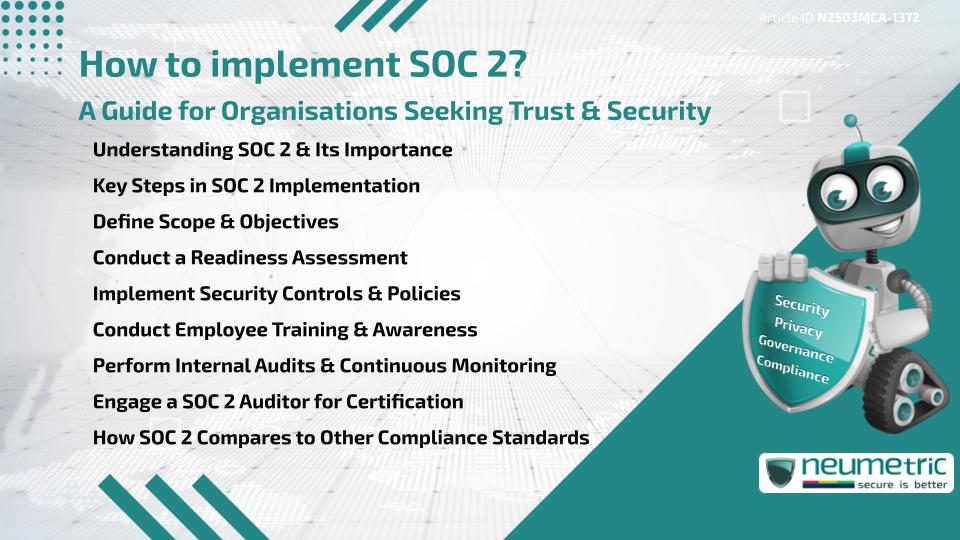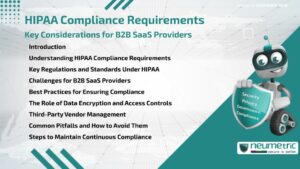Table of Contents
ToggleIntroduction
Organisations handling Sensitive Customer Data must ensure their Security practices meet Industry Standards. SOC 2 Compliance is a widely recognised Framework that helps businesses demonstrate strong Data Security & Operational Integrity. However, understanding how to implement SOC 2 can be challenging. This guide provides a structured approach to achieving SOC 2 Compliance, covering its background, practical steps & key considerations.
Understanding SOC 2 & Its Importance
SOC 2, developed by the American Institute of Certified Public Accountants [AICPA], is a Framework designed to ensure Service Providers manage Data securely. Unlike other Compliance Standards, SOC 2 Reports are tailored to each organisation’s specific needs. Achieving SOC 2 Compliance enhances Credibility, builds Customer Trust & strengthens Risk Management practices.
Key Steps on how to implement SOC 2?
Define Scope & Objectives
Before starting SOC 2 implementation, organisations must define the Scope. This involves identifying which Systems, Dervices & Data Handling processes fall under SOC 2 requirements. The scope should align with the five (5) Trust Services Criteria [TSC]:
- Security (mandatory for all SOC 2 Reports)
- Availability
- Processing Integrity
- Confidentiality
- Privacy
Conduct a Readiness Assessment
A Readiness Assessment helps identify existing Security Controls & potential Gaps. This step involves evaluating Policies, Procedures & Technologies against SOC 2 requirements. Conducting an Internal or Third Party Gap analysis can highlight areas that need improvement before undergoing an External Audit.
Implement Security Controls & Policies
Organisations must establish & enforce Security Controls to meet SOC 2 criteria. These controls typically include:
- Access Controls: Restricting access to Sensitive Data based on User Roles.
- Data Encryption: Ensuring Data is protected in transit & at rest.
- Monitoring & Logging: Keeping records of system activities to detect Security Incidents.
- Incident Response Plan: Preparing a structured approach for handling Security Breaches.
Conduct Employee Training & Awareness
Security is not just a technical issue; Employees play a crucial role in maintaining compliance. Organisations should provide training on Data Security policies, phishing prevention & best practices for handling Customer Data. Regular Security Awareness programs help mitigate human errors that could lead to compliance failures.
Perform Internal Audits & Continuous Monitoring
Regular Internal Audits help organisations evaluate their compliance status & address Vulnerabilities. Continuous Monitoring of Security Controls ensures that compliance is maintained over time. Automated Compliance Tools can assist in tracking changes & detecting potential risks.
Engage a SOC 2 Auditor for Certification
Once all controls are in place, organisations must engage a licensed Certified Public Accountant [CPA] firm to conduct a formal SOC 2 Audit. The Audit assesses whether the implemented Controls align with SOC 2 Standards. Depending on the organisation’s needs, they may choose:
- SOC 2 Type I Report: Evaluates Control design at a specific point in time.
- SOC 2 Type II Report: Assesses Control effectiveness over a monitoring period (typically three (3) to twelve (12) months).
Challenges & Limitations of SOC 2 Implementation
While understanding on how to implement SOC 2 & the significant benefits it offers, organisations may face challenges such as:
- Time & Resource Investment: Achieving compliance requires substantial effort & investment.
- Subjectivity in Audit Criteria: SOC 2 is not a one-size-fits-all Standard, leading to varying interpretations of requirements.
- Ongoing Maintenance: Compliance is not a one-time event; continuous monitoring & periodic reassessments are necessary.
How SOC 2 Compares to Other Compliance Standards
SOC 2 is often compared to other Security Frameworks like ISO 27001 & NIST CSF. Unlike ISO 27001, which requires a formal Certification, SOC 2 focuses on Independent Audit Reports. Similarly, while NIST CSF provides broad Cybersecurity guidelines, SOC 2 is more tailored to Service Organisations handling Customer Data.
Conclusion
Understanding how to implement SOC 2 is essential for organisations that prioritise Security & Compliance. By defining the Scope, assessing current security measures, implementing robust controls & undergoing an Audit, businesses can achieve SOC 2 Compliance & enhance Customer Trust.
Takeaways
- SOC 2 Compliance helps organisations build Trust & secure Customer Data.
- A readiness assessment is crucial for identifying Security Gaps.
- Security Controls, Training & Continuous Monitoring are key to maintaining compliance.
- Engaging a SOC 2 Auditor ensures official Certification.
- Compliance is an ongoing process that requires regular reviews.
- Key Steps on how to implement SOC 2
FAQ
What is SOC 2 & What is its importance?
SOC 2 is a Compliance Framework designed to ensure that Service Providers securely manage Customer Data. It enhances Trust, Security & Operational Integrity.
Duration to implement SOC 2?
The timeline varies but typically ranges from three (3) to twelve (12) months, depending on the organisation’s security maturity & resources.
Do all organisations need a SOC 2 Type II report?
Not necessarily. Some businesses start with a SOC 2 Type I report & later move to a SOC 2 Type II report for greater assurance.
Can small businesses achieve SOC 2 Compliance?
Yes. While SOC 2 Compliance requires investment, small businesses can leverage automation & external expertise to streamline the process.
Is SOC 2 a legal requirement?
No, SOC 2 is not legally required, but many organisations adopt it to meet Client expectations & regulatory best practices.





